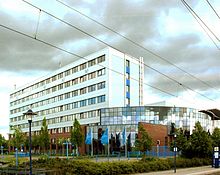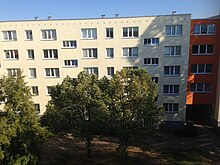Big Dreesch
|
Big Dreesch
City of Schwerin
Coordinates: 53 ° 36 '8 " N , 11 ° 25' 58" E
|
|
|---|---|
| Height : | 45-69 m above sea level NN |
| Residents : | 8289 (Sep. 30, 2017) |
| Postal code : | 19061 |
| Area code : | 0385 |
|
Location of the Großer Dreesch district in Schwerin
|
|
The Große Dreesch is a district of the Mecklenburg-Western Pomerania state capital Schwerin .
The Große Dreesch is located southwest of the Schweriner See and is touched by the federal highways Bundesstraßen 106 and 321 . The Großer Dreesch prefabricated building area was the largest district of Schwerin with around 62,000 inhabitants in 1989. After the fall of the Wall , the Großer Dreesch was divided into the districts of Großer Dreesch, Neu Zippendorf and Mueßer Holz according to its three construction phases .
Before the fall of the Wall, the Große Dreesch was described as the most beautifully located new building area in the GDR . From the hill on which the district is located, you have a good view of Lake Schwerin and the old town. The Zippendorfer Strand, popular for many Schwerin residents, and the Schwerin Zoological Garden are in the immediate vicinity.
history
The name Großer Dreesch comes from an old field name. Dreesch referred to a dormant arable land that was used as pasture and means 'wasteland' or 'wild land'. Another interpretation refers to the Dree contained in the name , Low German for three , which could indicate a three-field economy . In the Schmettauschen map from 1786 the area is still shown as a middle field .
The Dreesch was used by the Russian-German Legion as a training ground for the liberation struggle against Napoleon from September 1813, at that time the military installations in today's Stern Buchholz did not yet exist . In 1910 the airship Parseval 6 landed on the still undeveloped area .
Important location factors for the choice as a residential area were the nearby industrial area in Schwerin-Süd, which was being built at the same time. In addition, the building site had a good load-bearing capacity and a high proportion of wasteland with a low land value index . An expansion of the existing prefabricated building areas in Weststadt or Lankow was also considered in advance . The area of the first construction phase had belonged to the Schwerin urban area since 1928. The foundation stone for the 4829 residential units to be built for around 14,000 residents was laid on November 11, 1971. The first tenants were able to move into their apartments in February 1972, which belonged to the municipal housing company in Schwerin and the Schwerin housing association. The expected traffic flows required a spatial separation of tram and road traffic.
The publishing and printing building of the Schweriner Volkszeitung , which was built by April 1975, and a project building in the Straße der Deutsch-Soviet-Freundung (today: Dreescher Markt ), in which 750 people found work and, among other things, supply facilities were opened, achieved economic importance . In the residential area, in the first construction phase between Ludwigsluster Chaussee and Grünes Tal, which was previously named after 1990 , three school complexes were built with five schools, two department stores , a gas station in 1976, a polyclinic in 1977 and a swimming pool in 1981. The entire building complex was handed over on October 5, 1983.
Like all large prefabricated building areas in Eastern Germany , the Große Dreesch suffered from growing vacancies after 1990, caused by the dramatic fall in the birth rate after the fall of the Wall and the not inconsiderable relocation of previous residents to residential areas close to the city, redeveloped historic districts or western federal states. The Große Dreesch was less affected by this than the neighboring districts of Neu Zippendorf and Mueßer Holz .
In order to counteract the development of the Großer Dreesch into a social hotspot, supported by the Urban Redevelopment East program with funds from the federal government, the state and the city, the two large urban housing companies created higher quality and larger apartments and a more appealing living environment by means of demolition and renovation . Extensive demolition did not take place; of the nine high-rise buildings built in the 1970s, three were dismantled in 1999 and 2003, while the rest were renovated and modernized. In 1991, 1996 and 2001, three shopping centers were built in the new buildings, as well as some office buildings. A department store, the polyclinic and a kindergarten were demolished, while another former kindergarten was converted into living space suitable for the elderly. The swimming pool, built in 1981, was replaced in 2013-2015 by a new building serving the same purpose.
Worth seeing
- The Schwerin Inner Lake
- Schwerin Zoological Garden with around 2,400 animals of 154 species and almost 138,000 visitors annually.
- Sculpture Welcome to Schwerin from 1977
- To the north, by the road Am Grünen Tal: The “Green Valley” memorial for the 550 prisoners of war, most of whom came from the Soviet Union , France , Yugoslavia and Poland , discovered during construction work in 1961 and buried here in collective graves .
- Memorial stone from 1961
- Stele, 1978 by Wieland Schmiedel
- Information board from 2019
- Memorial from around 1950 as a boulder near the Faulen See for the death march of 1945 from Sachsenhausen concentration camp .
Transport links

The city center of Schwerin can be reached from here with the tram lines 1 and 2 in 10 minutes, the industrial area Schwerin-Süd with the lines 3 and 4. The bus lines 6, 9, 13, 16 and 19 also run.
The streets of the district were primarily named after personalities of contemporary history (e.g. Martin Luther King , Stauffenberg , Anne Frank ).
The large four-lane connecting roads as a ring around the district are Ludwigsluster Chaussee in the west , An der Crivitzer Chaussee in the north, Am Grünen Tal in the east and then south and Karl-Marx-Allee as the B 321.
Web links
- Dreesch-Schwerin - district portal
- Schweriner Turmblick - district newspaper
- "My record, my Dreesch, my home" , documentation of the "record jumpers" at FiS (television in Schwerin)
literature
- State capital Schwerin: district in transition - Großer Dreesch, Neu Zippendorf, Mueßer Holz . Schwerin 2002.
Individual evidence
- ^ Renate Herrmann-Winter, Low German-High German Dictionary, Hinstorff 1999, ISBN 3-356-00375-5
- ↑ a b Udo Brinker: Chronology in numbers. Dreesch is used by the military for the first time , Schweriner Volkszeitung, October 9, 2010
- ↑ a b Bernd Kasten and Jens-Uwe Rost: Schwerin. History of the city. Thomas Helms Verlag, Schwerin 2005. ISBN 3-935749-38-4






